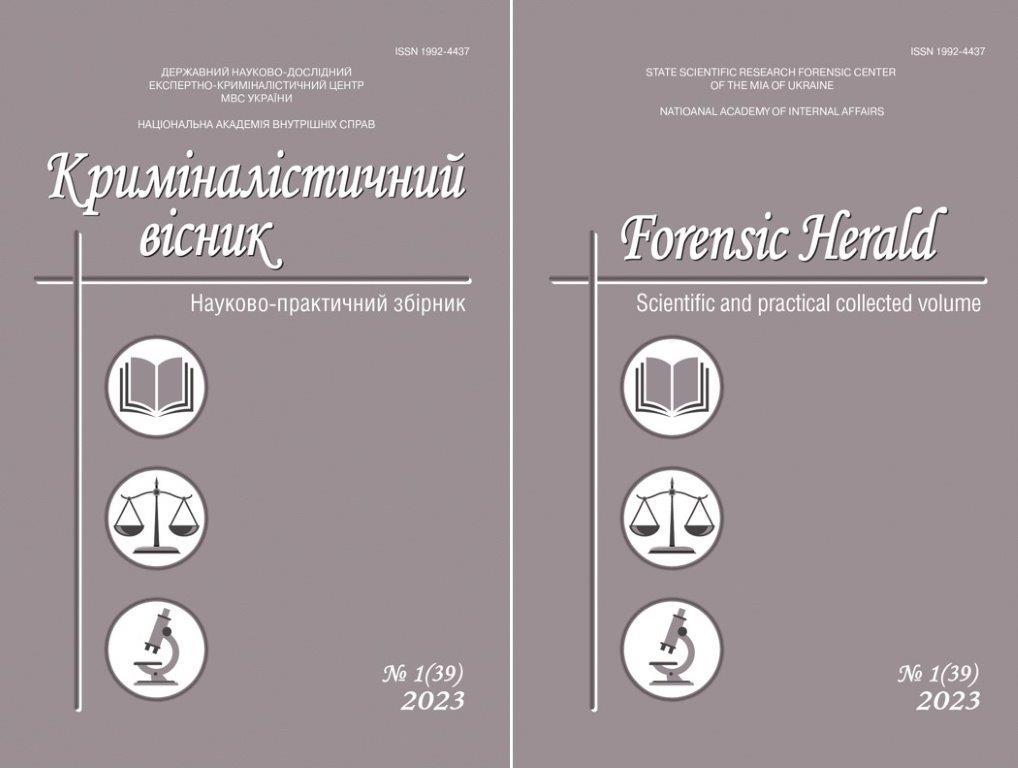MOLECULAR-GENETIC IDENTIFICATION OF PERSONS WHO DIED DURING RUSSIAN ARMED AGGRESSION AGAINST UKRAINE: SUCCESSES AND CHALLENGES
DOI:
https://doi.org/10.37025/1992-4437/2023-39-1-10Keywords:
forensic, DNA typing, DNA profile, sample preparation, genetic information, DNA databaseAbstract
The purpose of the article is to highlight main DNA identification problems caused by Russian invasion of
Ukraine, based on forensic experience of DNA typing in the units of the Expert Service of the Ministry of Internal
Affairs (MIA) of Ukraine. Methodology. General scientific methods (both empiric and theoretical), as well as special
methods of molecular biology and genetics, were used. The scientific novelty. The article examines and compares
technical, methodical and organizational problems of DNA identification that arose during three different time frames,
as well as the solutions that were used to solve these problems. Three time periods were reviewed: the period before
the beginning of Anti-Terrorist Operation (ATO) (2004–2013); the period of ATO and Joint Forces Operation (2014–
2021); the period from the beginning of the full-scale Russian invasion to the present days. The main themes of the article
are issues related to the rapid increase in the number of challenging disaster victim identification (DVI) cases
which are submitted to the units of the Expert Service of MIA, as well as ways to improve and modernize existing work
protocols to overcome these challenges. These upgrades include changing the sample collection process, modifying
DNA extraction protocols, automation of the laboratory workflow, upgrading the STR and mitochondrial DNA
analysis, implementing rapid-DNA technologies and using automated DNA databases to find matches. Conclusions.
The Russo-Ukrainian war is one of the biggest, challenge of modern DNA profiling in context of DVI. The number
of unidentified human remains and samples collected from relatives of the missing persons continues to grow every
day. This causes more pressure on the units of the Expert Service of MIA and other forensic institutions of Ukraine.
Highlighted that due to the different states of war-related human remains, DNA extracted from these remains may
have different quality problems, such as high degradation and the presence of a wide range of PCR inhibitors. These
problems are partly related to the Russian side's violation of the conditions for the storage of unburied bodies, which
leads to cycles of aerobic and anaerobic decay of body tissues. The experience of the Expert Service of MIA shows that
automation of such workflow steps as extraction, PCR and normalization preparation as well as the use of up-to-date
instruments and technics, in addition to the modification of existing protocols, allows to face and overcome all present
challenges in DNA typing, caused by Russian aggression against Ukraine. The National DNA Database allows efficient
searches for matches between possible relatives and unidentified human remains. This allows quick identification
of unburied bodies, despite the difficult conditions of war. But due the wartime, the problems related to the time
spent by forensic expert on drawing up a forensic report, become especially important. This problem can be solved
with harmonization between investigators, forensic medical experts and forensic DNA experts. This issue especially
appears at such stages as the formulation of questions in the documents submitted by investigators to forensic DNA
experts and during the collection of ante-mortem (AM) samples, post-mortem (PM) samples and reference samples
of relatives of missing persons.
Acknowledgments
The authors of the paper are deeply grateful to the personnel
of the DNA laboratory of the International Commission on Missing Persons
(The Hague, Netherlands) for consultations and demonstration
of the full bone demineralization procedure.



